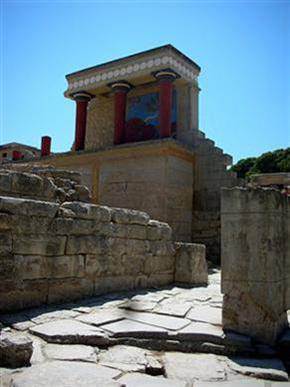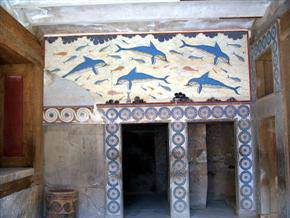Notable absentees at UNESCO World Heritage List
by G. Fernández – theartwolf.com
In 1972, UNESCO created the World Heritage List, in order to protect those sites of high cultural or natural importance to the whole humanity. New sites are added each year to the already extensive list containing nearly 1,000 sites, and, very rarely, some sites are delisted from the World Heritage List. However, there are notable absentees in this great list. Focusing on art and culture, theartwolf.com has selected 10 sites that, being or not being part of the official “tentative list” for the World Heritage List, really deserve to be part of this prestigious list.

Minoan Palaces of Knossos and Phaistos, Crete
The Minoan Temples of Knossos and Phaistos are the most important archaeological sites in Crete, and the best testimonies of the Minoan culture.
With more than 17,000 square meters, the Palace of Knossos is not only one of the most glorious ancient buildings in Greece, but also the home of one of the most important ancient paintings ever created, the Fresco of the Dolphins. In addition, the Temple is known as the ancient home of King Minos, who, according to the legend, kept the legendary Minotaur in a giant maze. The Temple of Phaistos (sometimes transliterated as Phaestos) was the place in which archaeologist Luigi Pernier found the famous Phaistos Disc, one of the most important antiquities from Ancient Greece.

The Palace of Knossos is part of the “Tentative List” since 2003. The Temple of Phaistos has never been included in that list
Temples in the Nile Valley, Egypt
Ancient Egypt is arguably the most glorious and famous of all ancient civilizations. For more than 3,000 years, Egyptian people built hundreds of temples and monuments along the fertile Nile Valley. However, between Cairo and Aswan only Ancient Thebes (now Luxor) is included in the World Heritage List. It’s not enough. Archeological sites as Abydos, Asyut, Amarna, or the Ptolemaic Temples of Dendera, Edfu and Kom Ombo well deserve to be included in the list, as outstanding testimonies of this great civilization.

“Pharaonic temples in Upper Egypt from the Ptolemaic and Roman periods” are included in the tentative list since 2003. Other sites as Abydos or Amarna have never been included in that list
Ur, Iraq
One of the most notorious absentees in the World Heritage List is Ur (we could also add other archaeological sites in Iraq, as Nimrud or Nineveh), one of the most important ancient cities of the world, capital of the Sumerian empire, (and, according to the Bible, birthplace of Abraham) in which you can still see the majestic Great Ziggurat of Ur-Nammu.
Since early 2009, the University of Pennsylvania joined forces with the Iraq authorities to resume archaeological works in Ur, a site included at the UNESCO Tentative List (as well as Nimrud and Wasit) in the summer of 2000
Bagan, Myanmar
Considered as one of the greatest ancient sites of Southeastern Asia, UNESCO has unsuccessfully tried to include Bagan in the World Heritage List (Bagan is included in the Tentative List since as early as 1996), only to find the intransigency of the military junta who is inaccurately restoring this archaeological marvel, including a golf course between the ancient pagodas and temples.

The inclusion of Bagan in the World Heritage List is highly desirable, though members of this prestigious list can also be victims of brainless governments, as it has been proved with the sad story of the Buddhas of Bamyan, destroyed by the Taliban in 2001
The Mother Temple of Besakih, Bali, Indonesia
Built during the 14th century a.C. on the slopes of Mount Agung, the most prominent volcano in Bali, the Mother Temple of Besakih is one of the main cultural and spiritual centers of the island. During the deadly eruption of Mount Agung in 1972 (in which more than 15,000 people were killed by the lava), the Temple remained intact, which led some people to believe that a divine intervention had protected the Temple.
Basakih was included in the Tentative List in 1995.

Chandigarh, India
This modern city in Northern India is famous for its rich architecture and urban planning, most of it created by Le Corbusier, one of the most important architects of the 20th century. The genius of the Swiss architect designed not only a rational city, but also a large number of concrete buildings, including the High Court and the Secretariat. Today, Chandigarh is also the most developed city in India.
Listed as “Urban and Architectural Work of Le Corbusier in Chandigarh”, the city was nominated to the UNESCO World Heritage List in October 2006.

Nalanda, India
One of the first universities and libraries in the world, Nalanda remains as one of the most fascinating ancient sites of India
According to the UNESCO, “the place rose into prominence in 5th Century A.D. as a great monastic-cum-educational institution for oriental art and learning in the whole Buddhist world, attracting students from like Hiuen Tsang and I-Tsing from China and other distant countries”. Recent excavations at Nalanda have uncovered more than 150,000 square meters of the ancient city, including a 30 meter wide avenue.
Nalanda was included in the Tentative List in January 2009.

The “Great Three” Monasteries of Tibet (Drepung, Ganden and Sera)
The Great Three Gelupka monasteries of Tibet are outstanding testimonies of the Buddhism.
Founded in 1416, Drepung Monastery is one of the world’s largest monasteries, even after the Chinese destroyed nearly half of the original building in 1951 (in 2008, the monastery was temporally closed after the monk-led protest against Chinese government). Built in the middle of a spectacular mountain landscape at an altitude of more than 4,700 meters, Ganden Monastery was founded in 1419, though it was almost totally destroyed in 1959. Since then, a slow rebuilding effort is being held by the monks. The third of these monasteries is Sera, founded in 1419, 5 km north of Lhasa.
None of these monasteries have ever been included in the Tentative List.

Historic Centre of Santa Fe, New Mexico, USA
The beautiful capital of New Mexico is a living testimony of the history of the American West.
Founded in 1598 by Spanish colonists, the “City different” showcases a very interesting group of adobe buildings, including the Palace of the Governors (1609), considered the oldest continuously occupied public building in the country, and the San Miguel Chapel (1610), the oldest church in the US.
Santa Fe has never been nominated to the UNESCO World Heritage List.

Pachacamac, Perú
40 km southeast of Lima, Pachacamac is one of the most important, famous and visited Incan archaeological sites in Peru.
This huge archaeological complex, which includes at least 17 pyramids, is, according to UNESCO, “the only precolonial Sanctuary City which represents the anden cosmogony, with a milenary path, felt through the different cultures of which it was the main center”. Pachacamac was the name of the ship appearing in “The Seven Crystal Balls”, a famous comic from the Tintín series.
Pachacamac was included in the Tentative list in 1996.

Follow us on:


